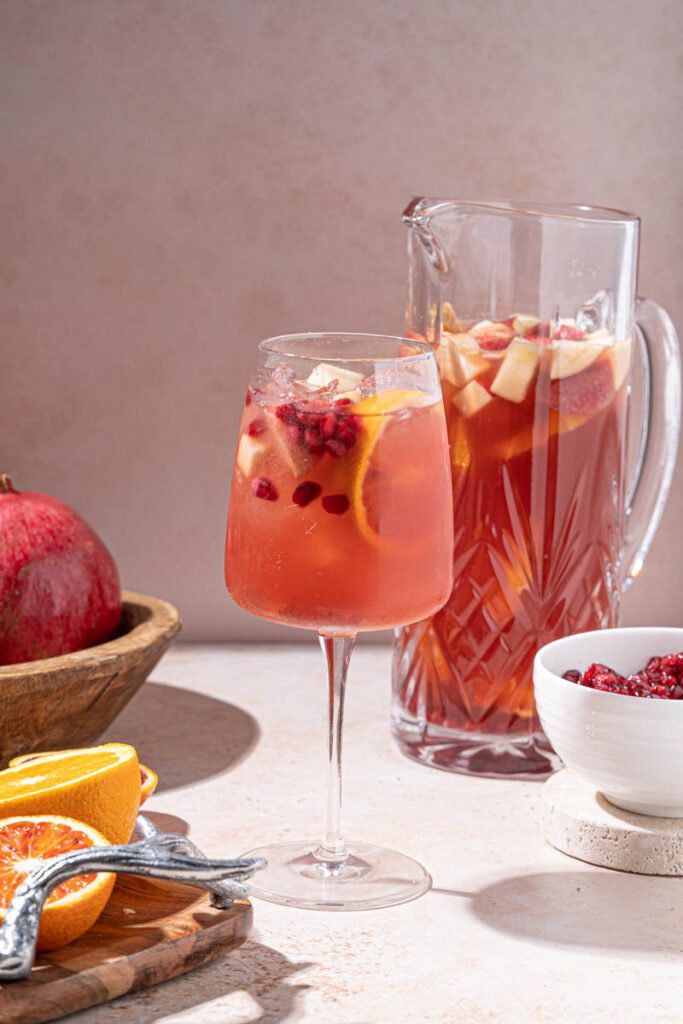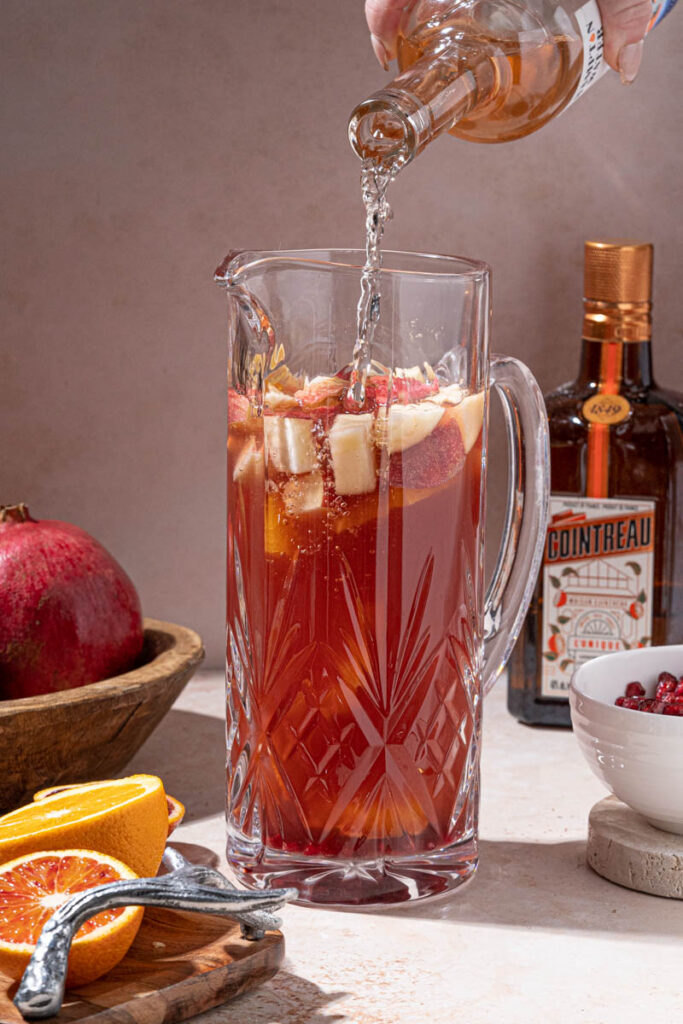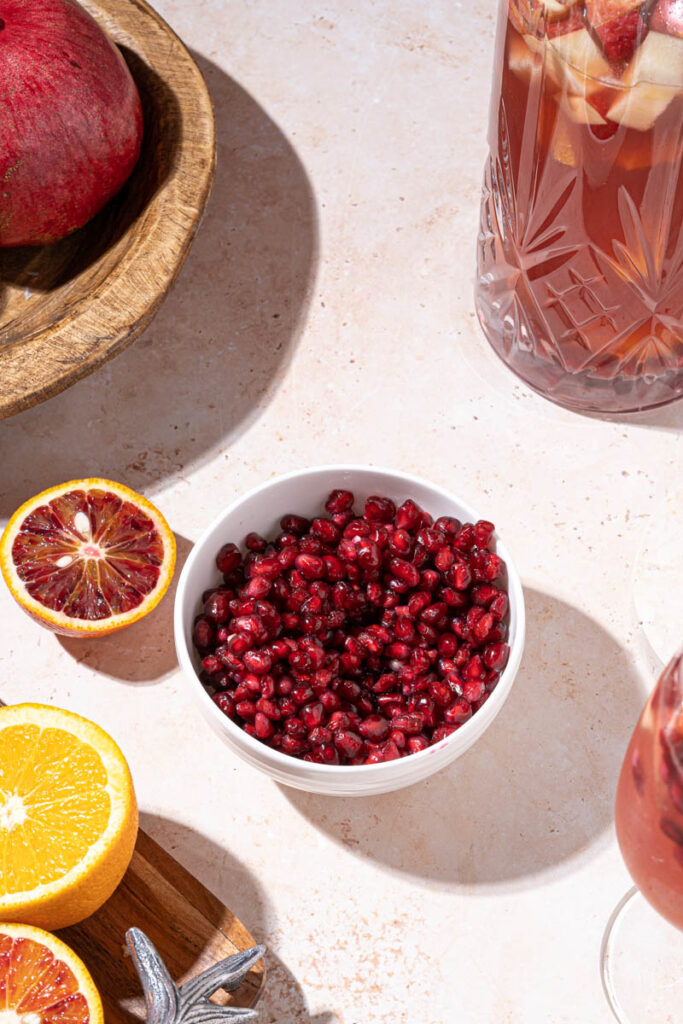
Sangria is a timeless and versatile concoction that effortlessly marries fruits, juices, and wine into a delightful symphony of flavors. One particular variation that stands out is the Pomegranate Blood Orange Sangria, a refreshing beverage perfect for any occasion.
In this blog post, we’ll explore the components that make this sangria special, from the choice of wine to the seasonal fruits that elevate its taste. Using fresh seasonal ingredients makes it the perfect sharable beverage for Thanksgiving and other holiday season gatherings.
Disclaimer: This blog may contain affiliate links, which means that I may earn a commission if you click on a link and make a purchase.
What is Sangria?
Sangria, a traditional Spanish punch, has transcended its origins and become a global favorite. This fruity and wine-based beverage often features a medley of fresh fruits, juices, and sometimes spirits, creating a refreshing and visually appealing drink. Sangria’s adaptability allows for endless variations, making it a go-to for both casual gatherings and elegant affairs.
What is Rosé Wine?
At the heart of our Pomegranate Blood Orange Sangria is Rosé wine, a delightful pink-hued wine crafted from red grape varietals. Unlike its red and white counterparts, Rosé undergoes a shorter fermentation process, resulting in its distinctive color and a flavor profile that combines the best of both worlds. Expect the fruity notes of red wine coupled with the crispness of white wine, making Rosé the ideal canvas for our vibrant sangria.
When are Blood Oranges in Season?
The key to infusing the sangria with a rich citrus flavor lies in the timing of using blood oranges. These deep-red, sweet-tart fruits are typically in season from December through April. Selecting blood oranges at the peak of their season ensures a burst of freshness and a vivid hue that enhances both the visual and gustatory experience of the sangria.
When are Pomegranates in Season?
Pomegranates, with their jewel-like seeds, add a delightful crunch and a burst of sweet-tart flavor to our sangria. Their peak season extends from September to February, making fall and winter the perfect time to incorporate this antioxidant-rich fruit into your recipes. Including pomegranates in your sangria not only enhances its taste but also contributes to its overall visual allure.
How to Make Simple Syrup:
Simple syrup serves as the sweet foundation of our sangria, seamlessly integrating sweetness without the graininess that can come from granulated sugar. To make simple syrup, combine equal parts water and sugar in a saucepan over medium heat. Stir until the sugar dissolves completely. Allow it to cool before incorporating it into your sangria. Adjust the quantity based on your preferred level of sweetness.


Helpful Tips:
- Chill to Thrill: The magic of sangria truly unfolds when allowed to chill and mingle. Refrigerate the sangria for a minimum of 2 hours before serving to let the flavors harmonize, resulting in a more satisfying and refreshing drink.
- Fruitful Garnishes: Elevate the visual appeal of your sangria by garnishing it with additional chopped fruit and a few pomegranate seeds. This not only adds a decorative touch but also allows guests to savor the flavors with every sip.
- Experiment and Personalize: Sangria is an open canvas for creativity. Feel free to experiment with the fruit combinations, adjust the sweetness, or even explore different wine varieties to tailor the recipe to your preferences.
- Quality Counts: Opt for fresh, high-quality ingredients. The better the ingredients, the more vibrant and delicious your sangria will be. Invest in a good bottle of Rosé wine and choose ripe, in-season fruits for the best results.


🍹 Home Bar Supplies You Might Need: 🍹
Before you start whipping out the ingredients to make this drink, make sure you have these essential bar tools in your kitchen first (or shop for them here):
Pomegranate and Blood Orange Rosé Sangria Recipe
Pomegranate and Blood Orange Rosé Sangria
Ingredients
- 1 blood orange
- 1 orange
- 1 chopped apple
- 1 chopped pear
- 1/4 cup pomegranate seeds
- ½ cup blood orange juice
- ½ cup pomegranate juice
- 4 oz simple syrup adjust to taste
- ½ cup Cointreau
- 1 bottle Rosé wine
Instructions
- Peel and slice the blood orange and orange into thin rounds.
- Chop the apple and pear into bite-sized pieces.
- In a large pitcher, combine the sliced blood orange, sliced orange, chopped apple, and chopped pear.
- Pour in the blood orange juice and pomegranate juice into the pitcher.
- Add the simple syrup to sweeten the sangria. Adjust the amount based on your sweetness preference.
- Pour in the Cointreau, which adds a citrusy and orange-flavored liqueur to the mix.
- Gently pour the entire bottle of Rosé wine into the pitcher. Stir the ingredients together to ensure everything is well combined.
- Place the pitcher in the refrigerator and let the sangria chill for at least 2 hours. This allows the flavors to meld and the sangria to become refreshing.
- Once the sangria has chilled, take the pitcher out of the refrigerator.
- Fill wine glasses with ice.
- Pour the sangria over the ice in each glass.
- Garnish the sangria with the chopped fruit (apple and pear) and additional blood orange slices for a decorative touch.


Leave a Reply